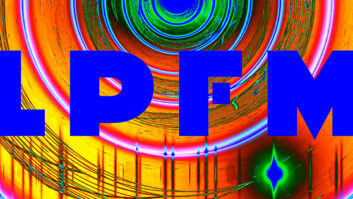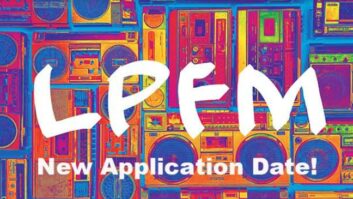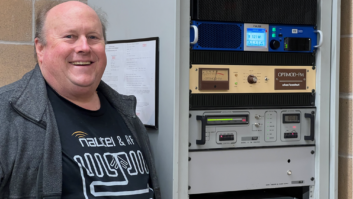HD Radio proponents have reiterated their request to the FCC to allow digital FMs to operate with asymmetric sideband levels as soon as practical. The idea has the support of a number of industry engineering heavyweights, and seems to face little opposition, at least judging from official comments filed with the commission.
Right now, those stations need a waiver from FCC rules to raise digital power levels unevenly. Allowing uneven power levels on a more routine basis would help more HD FMs raise their digital power and take advantage of data opportunities afforded by digital radio technology, like being able to transmit visual images synched with audio, proponents say. Higher power to enable digital coverage to match analog FM coverage is also critical to HD FM chips getting into mobile devices, they feel.
Beasley, CBS Radio, Emmis, Entercom, Greater Media, Journal, Lincoln Financial and Radio One as well as manufacturers Continental, Harris and Nautel submitted joint reply comments to the FCC on this topic that were due this week.
They support the iBiquity Digital and NPR proposal. They said the change would allow “numerous FM stations, whose digital power levels are currently limited by the requirement that they operate with equal, symmetric digital sideband power levels, to increase their digital coverage area and fill in locations where they currently experience service gaps without the creation of harmful interference to first adjacent stations.”
The Media Bureau’s January 2010 order allowed all FMs operating with an HD Radio signal voluntarily to increase their digital effective radiated power levels by 6 dB (from 20 dB below carrier, to –14 dBc), with some stations permitted to increase their digital power by as much as 10 dB (to –10 dBc), depending on distance separations from first-adjacent stations.
Most comments filed with the commission on this topic have supported asymmetric sideband operation, with one exception.
Jonathan Hardis, a member of the NRSC who works for NIST but wrote as an individual, opposes allowing stations to raise their digital power levels asymmetrically. Hardis doesn’t believe digital signals operating at –10 dBc would remain in compliance with the FCC’s FM emissions mask. He contends that the IBOC power level is 5 dB higher than the –25 dBc mask.
“The FCC of the early 1960s would not, under any circumstances, have read” the rules governing FM transmission system requirements “to allow type approval of an FM transmitter that put out 10% of its power off-channel (–10 dBc), or have allowed a radio station to operate in that manner,” Hardis states in reply comments.
The nine broadcast groups and four manufacturers responded in joint comments. Their submitted engineering statement (page 5) demonstrates Hardis has “incorrectly attempted to reinterpret the FM emissions mask rule,” they state.
“The traditional understanding and practice of the FCC and broadcast engineering community has been to treat each spurious emission as a separate entity with each IBOC carrier, as defined by the iBiquity specification, to be at -45.8 dBc2 or 20.8 dB below the mask,” state 12 engineers.
They are Beasley Broadcast Group VP of Engineering/CTO Mike Cooney; Harris Broadcast VP Transmission Research & Technology Geoffrey Mendenhall; Broadcast Electronics VP RF Engineering Brian Lindemann; Journal Broadcast Group VP/CTO Andrew Laird; CBS Radio SVP Engineering E. Glynn Walden; Lincoln Financial Media Co. VP Engineering Barry Thomas; Clear Channel Communications EVP Engineering & Systems Integration Jeff Littlejohn; Nautel Ltd. Head of Engineering Tim Hardy; Continental Electronics Corp. President Dan Dickey; Radio One Acting VP Corporate Engineering John Soller; Greater Media VP Engineering Milford Smith; and Warmus and Associates VP Roy Stype, also representing Carl E. Smith Consulting Engineers.
IBiquity states that Hardis’ comments represent his “long-standing opposition to all aspects of IBOC technology rather than any valid criticism of the asymmetric sideband proposal specifically. IBiquity disputes Hardis’ assertion that the technology developer’s power measurement methodology misstates digital power and that IBOC transmissions at power levels above –20 dBc violate section 73.317 of the commission’s rules.
The company argues that “the Hardis comments take issue with current industry practice, which does not include extended hybrid carriers when calculating digital power. In both cases, the IBOC operations in use throughout the radio industry comply with the commission’s rules and good technical practices that broadcasters have endorsed through open industry standards-setting activity.” Hardis’ concerns should be dismissed, according to iBiquity.
NPR agreed, writing that the requested authority “provides a means of improving digital coverage without causing interference.” NPR states Hardis’ opposition is irrelevant, pointing out it’s not based on the specific asymmetric sideband proposal but on disagreement with the FCC’s previous action in this IBOC proceeding, including the FM digital power increase in general.
Related:












